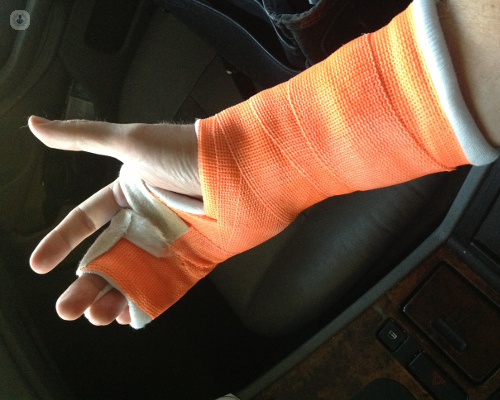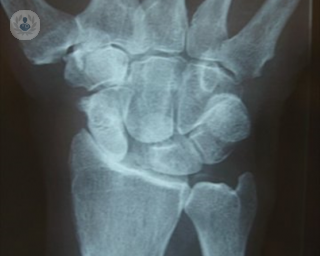Wrist fracture
Mr Medhat Zekry - Orthopaedic surgery
Created on: 03-30-2015
Updated on: 05-23-2023
Edited by: Sophie Kennedy
What is a wrist fracture?
A broken wrist or wrist fracture is when one or more of the bones in the wrist is cracked or broken. The most common type of wrist fracture is called a Colles’ fracture (or distal radius fracture). This type of break is a break in the larger of the two bones in the forearm. The bone usually breaks at the end where it connects with the hand and thumb. Wrist fractures occur through impact – either through playing sports, having fragile bones (osteoporosis) or falling down.
It is essential to treat a wrist fracture as not doing so could risk the bones healing incorrectly, which may cause problems in the future.

Symptoms of a wrist fracture
- Pain
- Bruising
- Swelling
- Stiffness and inability to move the fingers or thumb
- Numbness in the wrist or hand
Which medical tests can diagnose a wrist fracture?
An X-ray will determine the type of fracture. Sometimes a CT scan or MRI will be carried out as well to give the specialist more detail of any potential damage to soft tissue and blood vessels.
What are the causes of wrist fracture?
The main causes of a wrist fracture are car accidents, sports injuries and falls.
Can a wrist fracture be prevented?
Although you cannot prevent unforeseen events, there are measures that can help reduce the chances of injury. You can improve your bone strength by eating a healthy diet with enough calcium and vitamin D. Exercising frequently and being sure to do weight-bearing exercises too. It's also recommended to stop smoking if you do so.
To avoid falls it is advised to wear practical shoes (not high-heels or platforms). Move any tripping hazards. Make sure your vision is fine, or your glasses prescription is correct. When playing sports, make sure protective gear is being used.
Treatments for a wrist fracture
If the bones are misaligned, they will need to be reset so that they heal in the correct position. This can be painful, so anaesthesia can be given. A cast will be needed for up to 8 weeks, depending on how bad the fracture is.
Medications for a wrist fracture
To manage any pain, over-the-counter pain medication can be taken.
Which type of specialist treats a wrist fracture?
An orthopaedic surgeon is the specialist that will treat wrist fractures.
















